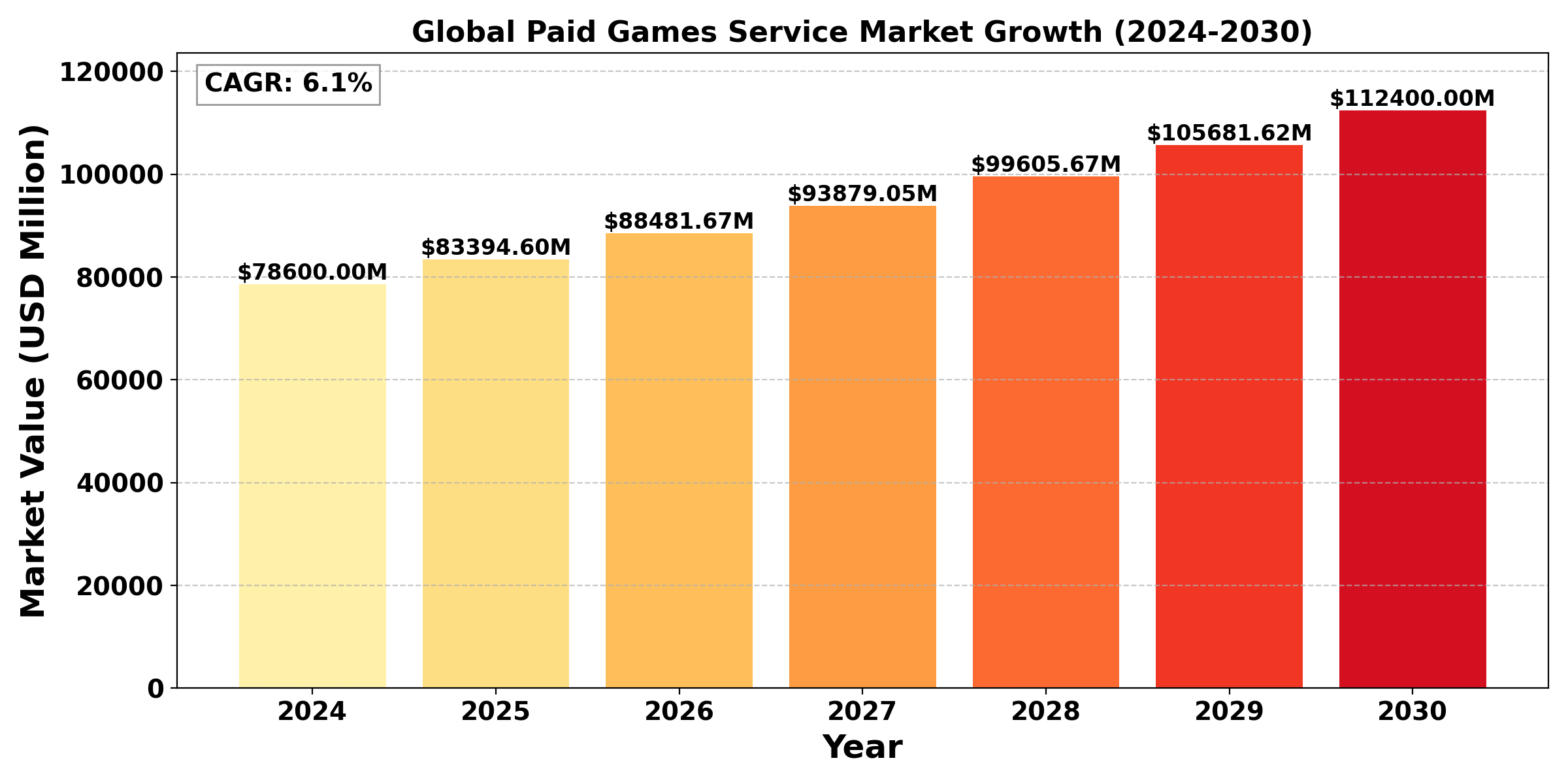TOP CATEGORY: Chemicals & Materials | Life Sciences | Banking & Finance | ICT Media

The "Global Paid Games Service Market" size was valued at US$ 78.6 billion in 2024 and is projected to reach US$ 112.4 billion by 2030, at a CAGR of 6.1% during the forecast period 2024-2030.
The "United States Paid Games Service Market" size was valued at US$ 24.3 billion in 2024 and is projected to reach US$ 33.7 billion by 2030, at a CAGR of 5.6% during the forecast period 2024-2030.
A Paid Games Service is a subscription-based platform where users pay a recurring fee to access a catalog of premium games. These services often provide unlimited access to a curated selection of games across various genres, offering exclusive content, early access, and sometimes in-game perks. Examples include Xbox Game Pass, PlayStation Plus, and Apple Arcade.
Online platforms and services that offer access to premium video games for a fee, including game purchases, subscriptions, and in-game content.
The global Paid Games Service market is experiencing steady growth, driven by increasing gaming popularity, advancements in cloud gaming technology, and the rise of subscription-based gaming models. Key players include Steam (Valve Corporation), PlayStation Network (Sony), and Xbox Game Pass (Microsoft). In 2024, individual game purchases accounted for 55% of the market, with subscription services growing at 9.5% annually. The industry is seeing significant adoption of cross-platform gaming services, improving user engagement by up to 40%. There's rising demand for cloud gaming services that eliminate the need for high-end hardware, now representing 15% of new service subscriptions. Providers are developing AI-powered game recommendation systems, increasing average user spending by 20% in early implementations. The market is benefiting from the integration of social features and esports functionality within gaming platforms. Challenges include managing game library costs and addressing concerns about game ownership in digital formats. The US market shows high engagement with paid gaming services, with an average annual spend of $120 per gamer on digital game content.

Report Overview
This report provides a deep insight into the global Paid Games Service market covering all its essential aspects. This ranges from a macro overview of the market to micro details of the market size, competitive landscape, development trend, niche market, key market drivers and challenges, SWOT analysis, value chain analysis, etc.
The analysis helps the reader to shape the competition within the industries and strategies for the competitive environment to enhance the potential profit. Furthermore, it provides a simple framework for evaluating and accessing the position of the business organization. The report structure also focuses on the competitive landscape of the Global Paid Games Service Market, this report introduces in detail the market share, market performance, product situation, operation situation, etc. of the main players, which helps the readers in the industry to identify the main competitors and deeply understand the competition pattern of the market.
In a word, this report is a must-read for industry players, investors, researchers, consultants, business strategists, and all those who have any kind of stake or are planning to foray into the Paid Games Service market in any manner.
Global Paid Games Service Market: Market Segmentation Analysis
The research report includes specific segments by region (country), manufacturers, Type, and Application. Market segmentation creates subsets of a market based on product type, end-user or application, Geographic, and other factors. By understanding the market segments, the decision-maker can leverage this targeting in the product, sales, and marketing strategies. Market segments can power your product development cycles by informing how you create product offerings for different segments.
Key Company
Chapter Outline
Chapter 1 mainly introduces the statistical scope of the report, market division standards, and market research methods.
Chapter 2 is an executive summary of different market segments (by region, product type, application, etc), including the market size of each market segment, future development potential, and so on. It offers a high-level view of the current state of the Paid Games Service Market and its likely evolution in the short to mid-term, and long term.
Chapter 3 makes a detailed analysis of the market's competitive landscape of the market and provides the market share, capacity, output, price, latest development plan, merger, and acquisition information of the main manufacturers in the market.
Chapter 4 is the analysis of the whole market industrial chain, including the upstream and downstream of the industry, as well as Porter's five forces analysis.
Chapter 5 introduces the latest developments of the market, the driving factors and restrictive factors of the market, the challenges and risks faced by manufacturers in the industry, and the analysis of relevant policies in the industry.
Chapter 6 provides the analysis of various market segments according to product types, covering the market size and development potential of each market segment, to help readers find the blue ocean market in different market segments.
Chapter 7 provides the analysis of various market segments according to application, covering the market size and development potential of each market segment, to help readers find the blue ocean market in different downstream markets.
Chapter 8 provides a quantitative analysis of the market size and development potential of each region and its main countries and introduces the market development, future development prospects, market space, and capacity of each country in the world.
Chapter 9 introduces the basic situation of the main companies in the market in detail, including product sales revenue, sales volume, price, gross profit margin, market share, product introduction, recent development, etc.
Chapter 10 provides a quantitative analysis of the market size and development potential of each region in the next five years.
Chapter 11 provides a quantitative analysis of the market size and development potential of each market segment (product type and application) in the next five years.
Chapter 12 is the main points and conclusions of the report.
Frequently Asked Questions ?
